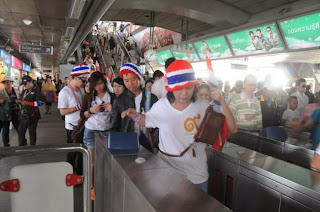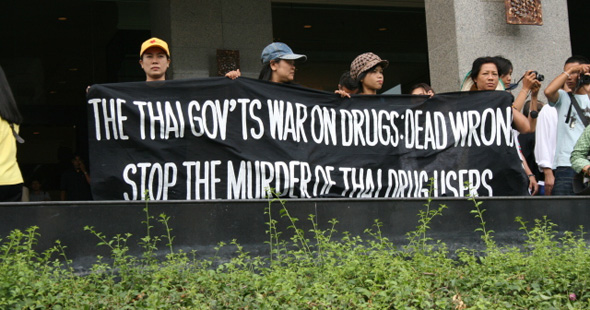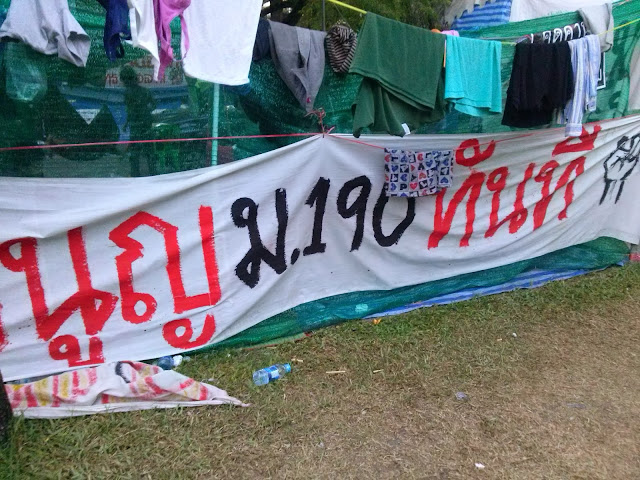Thailand: Third Mass Mobilization Floods Bangkok’s Streets
For the third time in the past two months, hundreds of thousands of peaceful protesters took to the streets from early morning until late night, paralyzing Thailand’s capital of Bangkok throughout the day. Major roads were turned into walking streets as tens of thousands of protesters assembled at each of over 10 stages throughout the city’s major intersections.
Thousands of protesters streamed between the stages, walking, riding, or driving miles from one stage to the other. Across the city, in every place of business, the signature Thai flag, ribbons, wrist bands, and banners could be seen carried by protesters as they took breaks to eat and rest. Each protest site was filled to capacity, with a steady stream of people flowing to and from the sites throughout the day. Mass transit systems ran out of tickets and eventually opened gates to let passengers ride for free.
 |
| Protest-numbers overwhelm Bangkok’s mass transit. |
The regime’s police have claimed the number of protesters at 4pm was approximately 135,000 – which would still dwarf by nearly 3 times the largest pro-regime rallies at the height of its popularity years ago. However, pictures, accounts, security officials and the fact that people were constantly arriving throughout the day as others left to sustain the crowds indicate a million or more turned out. The city’s elevated train alone moved over 700,000 people, most of whom were protesters.
Meanwhile, the regime’s proxy prime minister, Yingluck Shinawatra, placeholder for her convicted criminal brother, fugitive, Thaksin Shinawatra who openly runs the country from abroad as he evades a 2 year jail sentence, multiple arrest warrants and a long list of pending court cases, has fled to Thailand’s northern provinces where the remaining stronghold of the regime’s “red shirt” mobs desperately attempt to cling to power through a campaign of fear and intimidation.
Despite overwhelming opposition, increasing awareness around the world of the cartoonish nepotism and illegitimacy of the current regime, Yingluck Shinawatra was once again placed at the top of the candidate’s list for Thaksin Shianwatra’s “Peua Thai Party” (For Thais Party) for upcoming February 2014 elections being boycotted by opposition parties.
Who are the Protesters & What Do They Want?
The protesters demand the end of the Thaksin Shinawatra regime. To understand why, we must first understand who Thaksin Shinawatra is and what he has done over the past decade:
- In the late 1990’s, Thaksin was an adviser to notorious private equity firm, the Carlyle Group. He pledged to his foreign contacts that upon taking office, he would still serve as a “matchmaker” between the US equity fund and Thai businesses.
- Thaksin was Thailand’s prime minister from 2001-2006. Has since dominated the various reincarnations of his political party – and still to this day runs the country by proxy, via his nepotist appointed sister, Yingluck Shinawatra.
- In 2001 he privatized Thailand’s resources and infrastructure including the nation’s oil conglomerate PTT – much to Wall Street’s delight.
- In 2003, he would commit Thai troops to the US invasion of Iraq, despite widespread protests from both the Thai military and the public. Thaksin would also allow the CIA to use Thailand for its abhorrent rendition program.
- Also in 2003, he initiated what he called a “war on drugs.” 3,000 were extrajudicially murdered in the streets over the course of just 90 days. It would later turn out that more than half of those killed had nothing to even do with the drug trade. In this act alone, Thaksin earned himself the title as worst human rights offender in Thai history, and still he was far from finished.
- In 2004, he oversaw the killing of 85 protesters in a single day during his mishandled, heavy-handed policy in the country’s troubled deep south. The atrocity is now referred to as the “Tak Bai incident.”
- Also in 2004, Thaksin attempted to ramrod through a US-Thailand Free-Trade Agreement (FTA) without parliamentary approval, backed by the US-ASEAN Business Council who just before the 2011 elections that saw Thaksin’s sister Yingluck Shinawatra brought into power, hosted the leaders of Thaksin’s “red shirt” “United Front for Democracy against Dictatorship” (UDD) in Washington DC.
- Throughout his administration he was notorious for intimidating the press, and crushing dissent. According to Amnesty International, 18 human rights defenders were either assassinated or disappeared during his first term in office. The Committee to Protect Journalists (CPJ) claimed in its report, “Attacks on the Press 2004: Thailand” that the regime was guilty of financial interference, legal intimidation, and coercion of the press.
- Since the 2006 coup that toppled his regime, Thaksin has been represented by US corporate-financier elites via their lobbying firms including, Kenneth Adelman of the Edelman PR firm (Freedom House, International Crisis Group,PNAC), James Baker of Baker Botts (CFR, Carlyle Group), Robert Blackwill (CFR) of Barbour Griffith & Rogers (BGR), Kobre & Kim, Bell Pottinger (and here) and currently Robert Amsterdam of Amsterdam & Partners (Chatham House).
4. The Re-Nationalization of Thailand’s Oil – Thailand’s oil giant, PTT, was privatized and sold off to foreign multinationals under Thaksin Shinawatra in late 2001. Tremendous wealth has been siphoned out of Thailand and sent overseas, particularly to Chevron, one of the many sponsors on the US-ASEAN Business Council that directly supports the Shinawatra regime.
5. Keep Thailand Anti-GMO, Anti-IP – The current Thai establishment resisting the Thaksin regime has been stalwartly defending against GMO and “intellectual property” (IP) laws pushed on them by the United States, the UK, and the EU. In fact, one of the main points of attack by Thaksin Shinawatra’s Washington lobbyists, was attacking the military council that ousted Thaksin for ignoring US pharmaceutical patents while producing cheaper drugs for poor patients. Regarding GMO, Monsanto has been desperately trying to overrun Thailand’s food security but to no avail. Would it surprise readers to know that the US-ASEAN Business Council directly supporting Thaksin Shinawatra and his political machine also includes Monsanto?6. Keep Thailand Sovereign – It was recently revealed that the current regime hired the US lobbying firm of Davenport McKesson to, among other things, help arrange the building of a US Navy base in Thailand. Of course, considering the other demands of the protesters, this is unacceptable. Not only must this deal be investigated it must be rolled back and the mechanisms that have allowed it to proceed as far as it did in the first place, be taken apart permanently.
Students from Chulalongkorn University had brought up this issue at the Siam site yesterday and signs denouncing the US Navy base had already begun to circulate. The regime has since denied this, and the original PDF found on the US lobbying disclosure site FARA has been promptly taken down (it can be found here on Scribd).
What’s Next?
Protesters had promised to open roads late Sunday and promptly did so. The masses shifted from the multitude of stages across the city to the permanent protest encampment at Democracy Monument in the old quarter of Bangkok. Others moved to Bangkok’s Din Daeng area to surround the police station and the site where the regime plans to hold registration for an election only they will be running in. The goal is to disrupt this and prevent even show elections from taking place – forcing the regime to further expose its illegitimacy and eventually collapse.
For Thaksin Shinawatra and his foreign sponsors, they can afford to cling to power to the bitter end. After all, neither has anything to lose, and everything to gain. It will be their proxies who pay the price when the inevitable happens – and the longer they help Thaksin cling to power, the graver the consequences will be when they finally fail.
The anti-regime forces have proven they can mobilize unprecedented numbers time and time again, and have demonstrated that not only are the protest leaders becoming better organized and their message spreading, but those under their various banners are also becoming better organized in smaller, smarter groups. For the regime, the prospect of “riding out” unrest is not an option.









